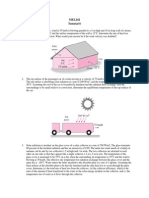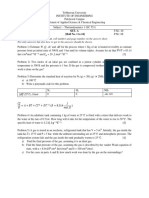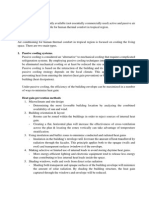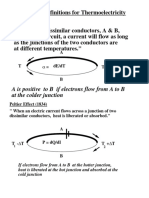Homework-4 - Spring 2021
Uploaded by
Ahmet KuralHomework-4 - Spring 2021
Uploaded by
Ahmet KuralISH 202 E, Introduction to Heat Transfer
Spring 2021
Homework 4
1. The passenger compartment of a minivan traveling at 95 km/h can be modeled as a 1 m
high, 1.8 m wide, and 3.4 m long rectangular box whose walls have an insulating value pof
R-0.5 (i.e., a wall thickness to thermal conductivity ratio of 0.5 m2.°C/W). The interior of a
minivan is maintained at an average temperature of 20C during a trip at night while the
outside air temperature is 30C. The average heat transfer coefficient on the interior
surfaces of the van is 6.8 W/m2. C. The air flow over the exterior surfaces can be assumed
to be turbulent because of the intense vibrations involved, and the heat transfer coefficient
on the front and back surfaces can be taken to be equal to that on the top surface.
Disregarding any heat gain or loss by radiation, determine the rate of heat transfer from the
ambient air to the van.
2. Consider a person who is trying to keep cool on a hot summer day by turning a fan on and
exposing his body to air flow. The air temperature is 32C, and the fan is blowing air at a
velocity of 5 m/s. The surrounding surfaces are at 40C, and the emissivity of the person
can be taken to be 0.9. If the person is doing light work and generating sensible heat at a
rate of 90 W, determine the average temperature of the outer surface (skin or clothing) of
the person. The average human body can be treated as a 30 cm diameter cylinder with an
exposed surafce area 1.7 m2.
3. Hot air at 60°C leaving the furnace of a house enters a 12 m long section of a sheet metal
duct of rectangular cross section 20 cm x 20 cm at an average velocity of 4 m/s. The
thermal resistance of the duct is negligible, and the outer surface of the duct, whose
emissivity is 0.30, is exposed to the cold air at 10°C in the basement, with a convection
heat transfer coefficient of 10 W /m2.°C. Taking the walls of the basement to be at 10°C
also, determine;
a. The temperature at which the hot air will leave the basement and,
b. The rate of heat loss from the hot air in the duct to the basement.
4. Air enters a 7 m long section of a rectangular duct of cross section 15 cm x 20 cm at 50°C
at an average velocity of 7 m/s. If the walls of the duct are maintained at 10°C, determine,
a. The outlet temperature of the air
b. The rate of heat transfer from the air, and
c. The fan power needed to overcome the pressure losses in this section of the duct.
You might also like
- Experiment 2: Calorimetry Calorimetry Is A Method of Measuring The Heat Transfer Within A Chemical Reaction or Other67% (3)Experiment 2: Calorimetry Calorimetry Is A Method of Measuring The Heat Transfer Within A Chemical Reaction or Other7 pages
- Flow of Hot Oil Over A Flat Plate:: External Forced Convection100% (1)Flow of Hot Oil Over A Flat Plate:: External Forced Convection8 pages
- ME3691-HEAT AND MASS TRANSFER-1565247191-ME3691 HMT Reg 2021 Question BankNo ratings yetME3691-HEAT AND MASS TRANSFER-1565247191-ME3691 HMT Reg 2021 Question Bank14 pages
- 1.1 Basics of Heat Transfer - Prob. SheetNo ratings yet1.1 Basics of Heat Transfer - Prob. Sheet3 pages
- CH250: Heat Transfer Assignment: o o o oNo ratings yetCH250: Heat Transfer Assignment: o o o o4 pages
- Practice Problem Set 1 - Three Heat Transfer Techniques0% (1)Practice Problem Set 1 - Three Heat Transfer Techniques4 pages
- ME436: Heat Transfer: 1 Flow Over A Flat PlateNo ratings yetME436: Heat Transfer: 1 Flow Over A Flat Plate3 pages
- Principles of Food and Bioprocess Engineering (FS 231) Problems On Heat TransferNo ratings yetPrinciples of Food and Bioprocess Engineering (FS 231) Problems On Heat Transfer8 pages
- Department of Mechanical Engineering Question Bank Subject Name: HEAT & MASS TRANSFER Year/Sem: III / V Unit - I Conduction Part - ANo ratings yetDepartment of Mechanical Engineering Question Bank Subject Name: HEAT & MASS TRANSFER Year/Sem: III / V Unit - I Conduction Part - A20 pages
- MEL242 Heat and Mass Transfer Tutorial Sheet 1No ratings yetMEL242 Heat and Mass Transfer Tutorial Sheet 12 pages
- Encyclopaedia Britannica, 11th Edition, Volume 8, Slice 3 "Destructors" to "Diameter"From EverandEncyclopaedia Britannica, 11th Edition, Volume 8, Slice 3 "Destructors" to "Diameter"No ratings yet
- Get (Original PDF) Fundamentals of Heat and Mass Transfer 8th Edition free all chapters100% (1)Get (Original PDF) Fundamentals of Heat and Mass Transfer 8th Edition free all chapters55 pages
- flashcards-for-neet-chemistry-nov12-equilibriumNo ratings yetflashcards-for-neet-chemistry-nov12-equilibrium4 pages
- Print - Acid Base Buffer - Vol6b OutputNo ratings yetPrint - Acid Base Buffer - Vol6b Output22 pages
- 01.4TB.123 Condensation in Switchgear and Anti-Condensation HeatersNo ratings yet01.4TB.123 Condensation in Switchgear and Anti-Condensation Heaters3 pages
- Basic Concepts of Thermodynamics: Presented By: Akash Pandey Asstt. Prof. DME, OPJUNo ratings yetBasic Concepts of Thermodynamics: Presented By: Akash Pandey Asstt. Prof. DME, OPJU41 pages
- + ( ) ( ) Handerson Hasselbalch EquationNo ratings yet+ ( ) ( ) Handerson Hasselbalch Equation2 pages
- Measurement of An Enthalpy Change: Measuring The Enthalpy Change For A Reaction Experimentally Calorimetric MethodNo ratings yetMeasurement of An Enthalpy Change: Measuring The Enthalpy Change For A Reaction Experimentally Calorimetric Method5 pages
- AISSMS College of Engineering Department of Chemical Engineering Unit Wise Question Bank: Mass Transfer T.E. (ChemicalNo ratings yetAISSMS College of Engineering Department of Chemical Engineering Unit Wise Question Bank: Mass Transfer T.E. (Chemical14 pages
- Test Method RC 91109 Calibration of A Drying Oven100% (1)Test Method RC 91109 Calibration of A Drying Oven5 pages

























































































